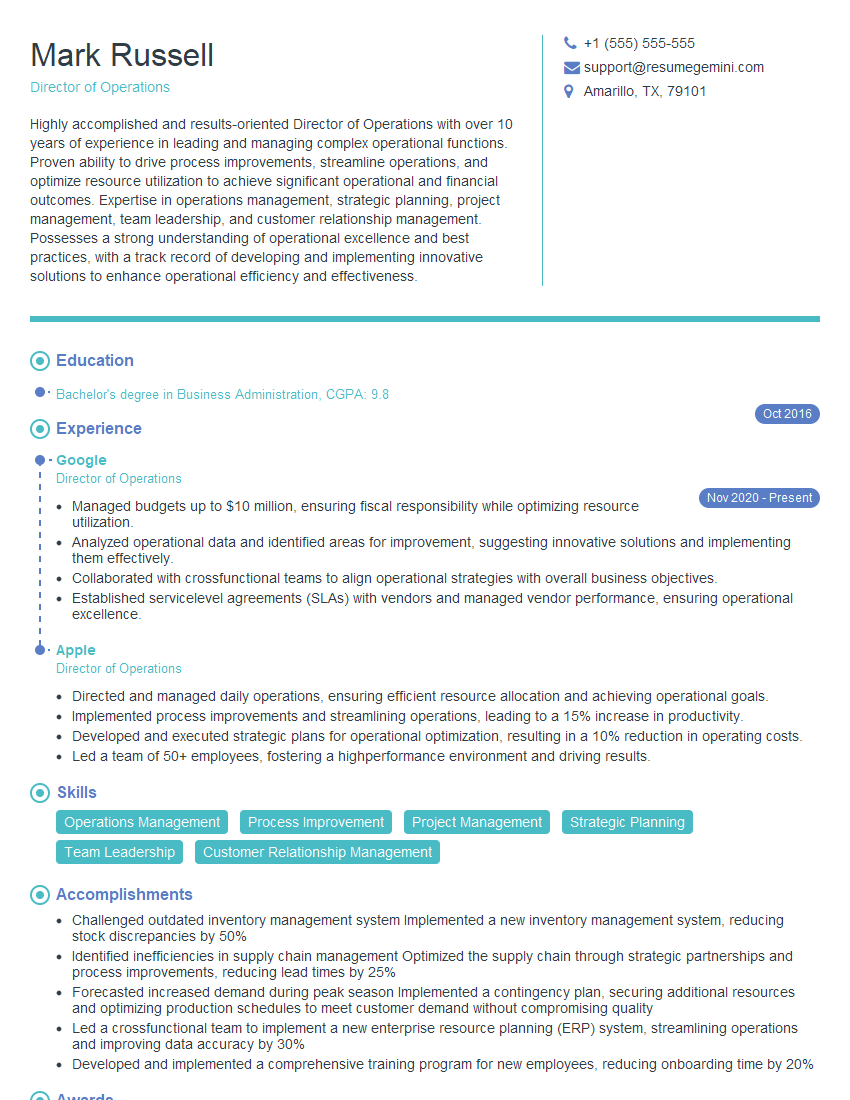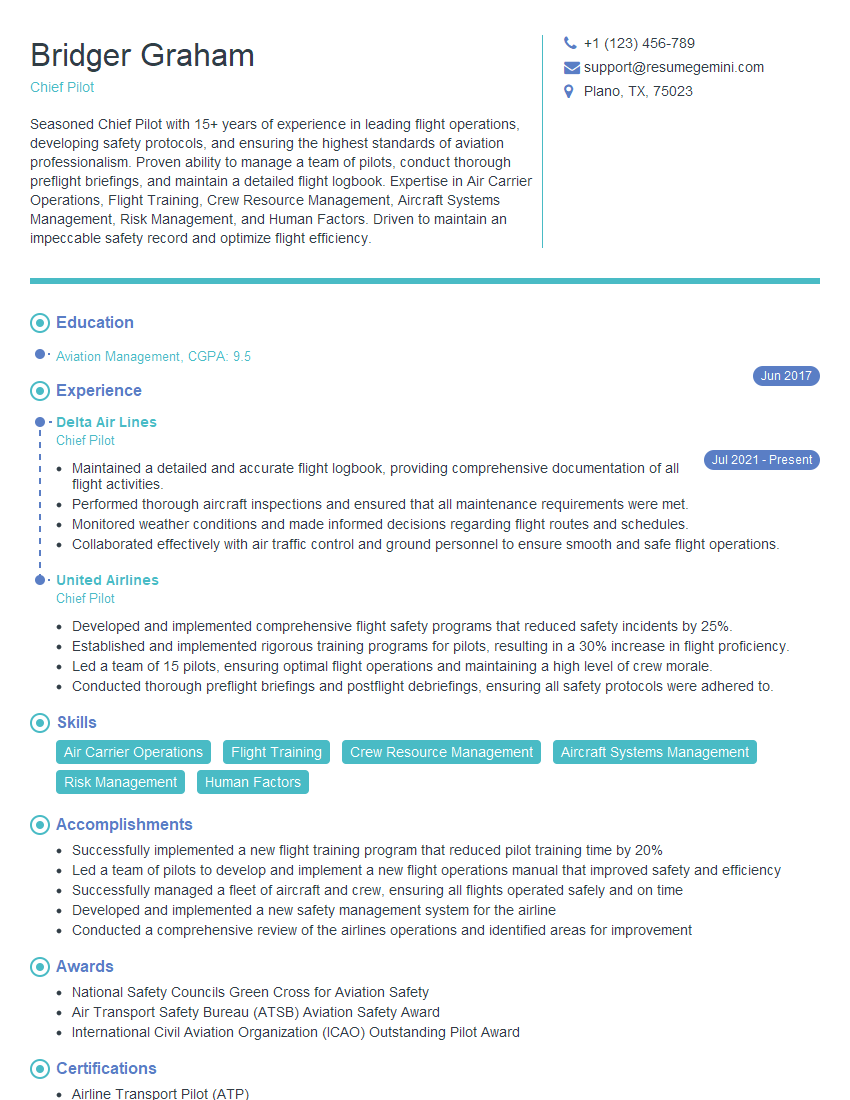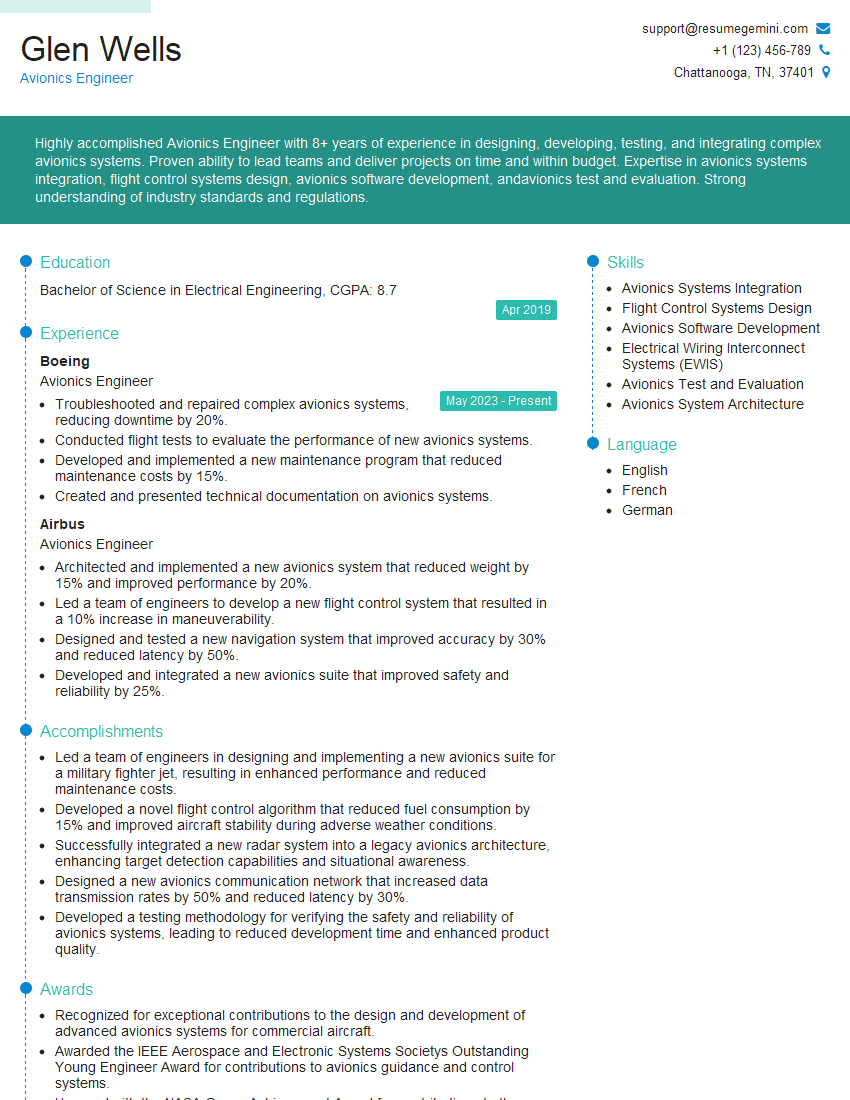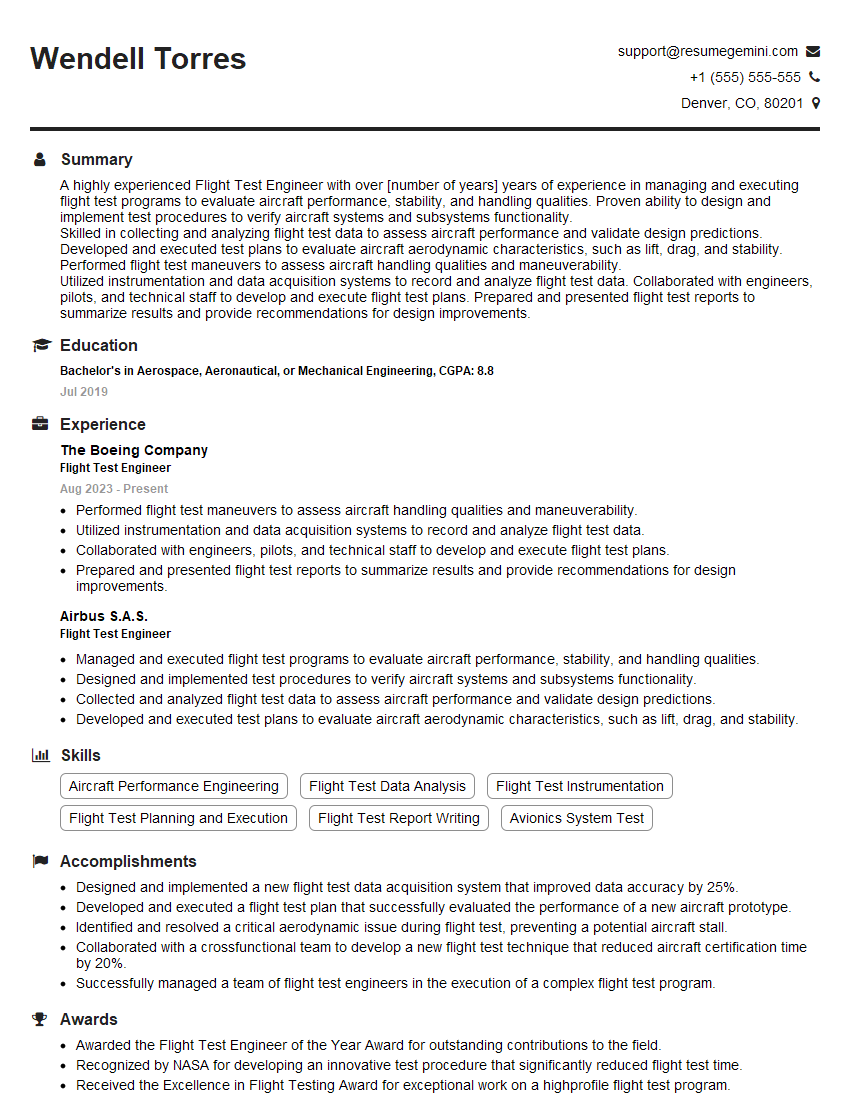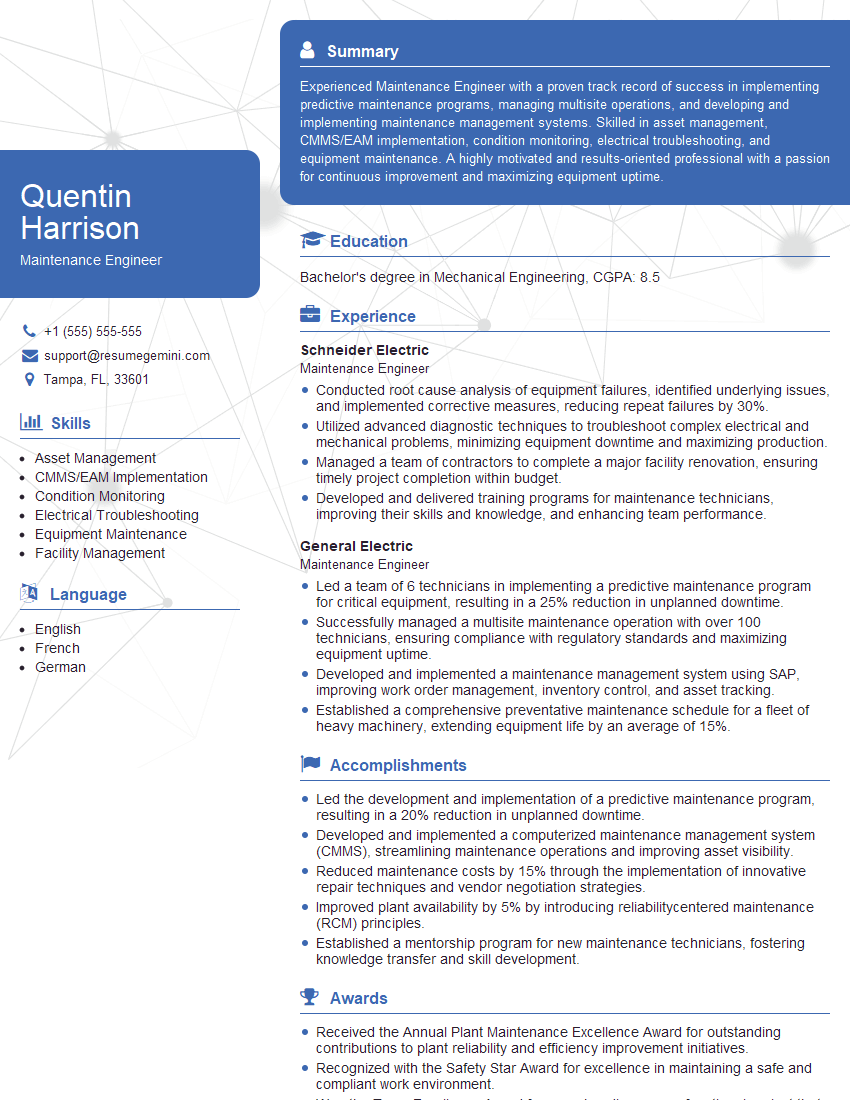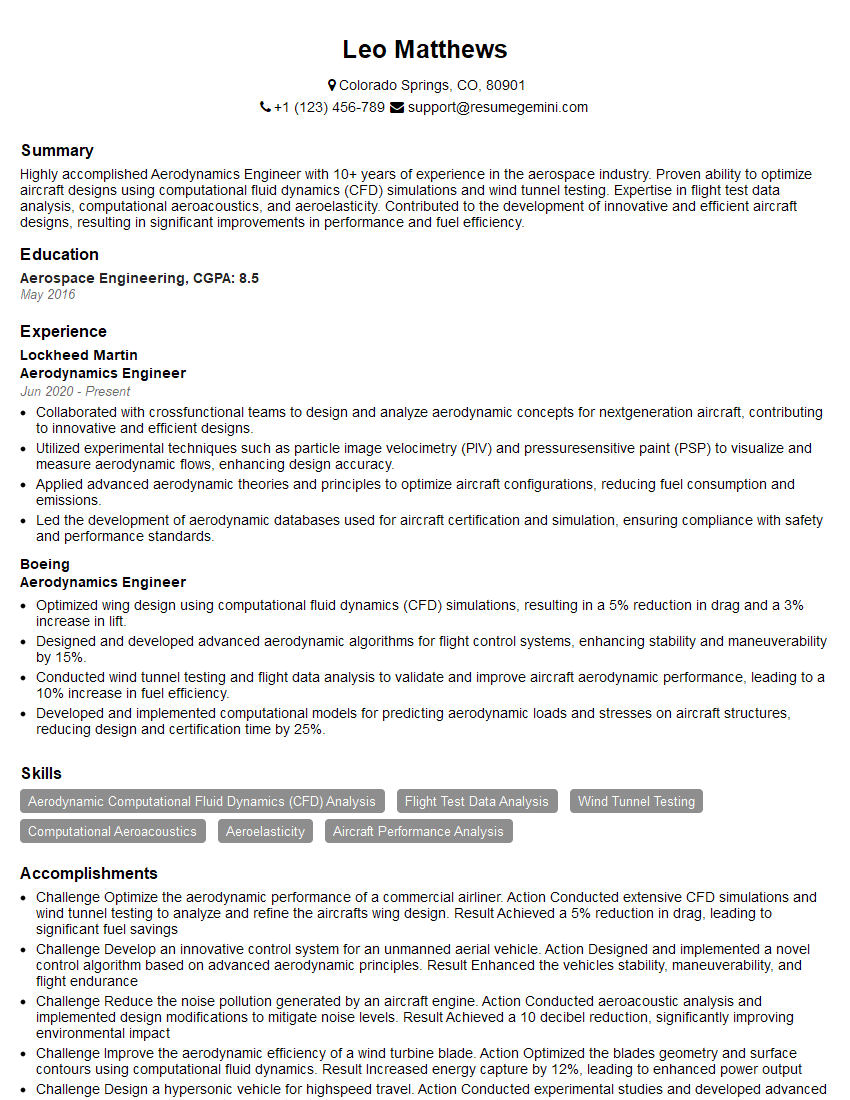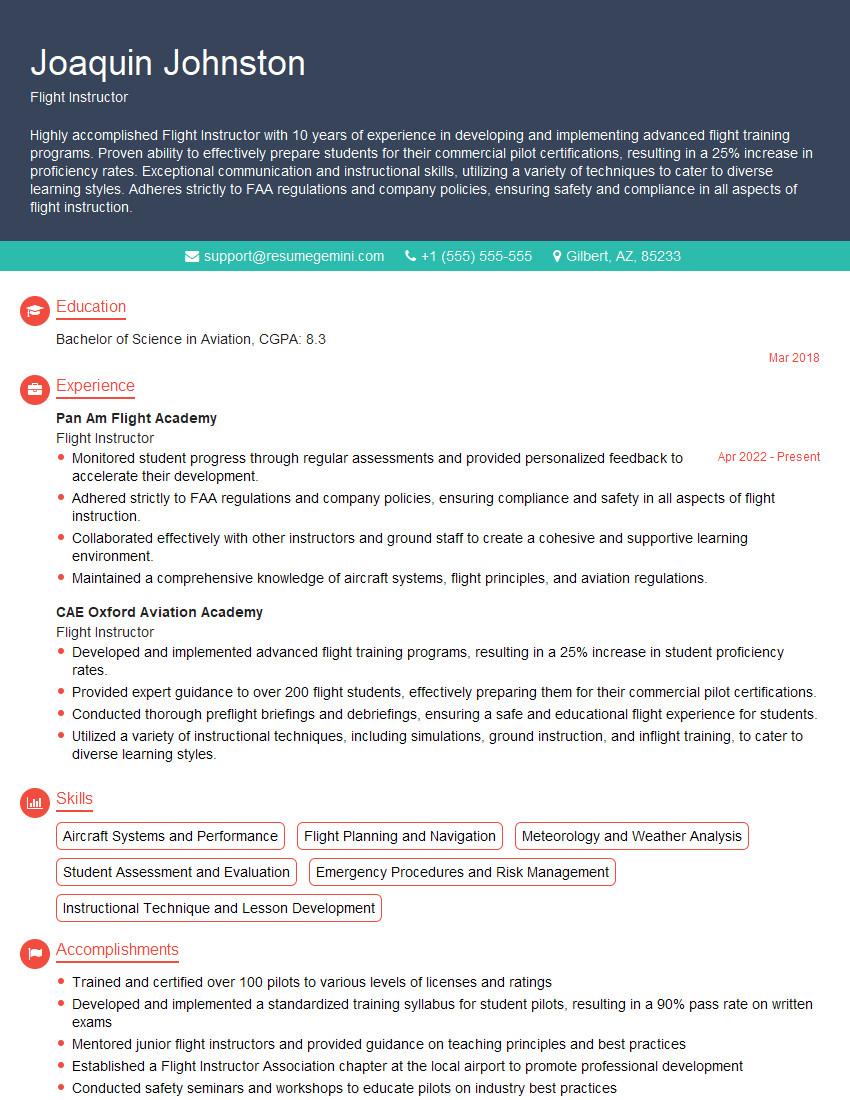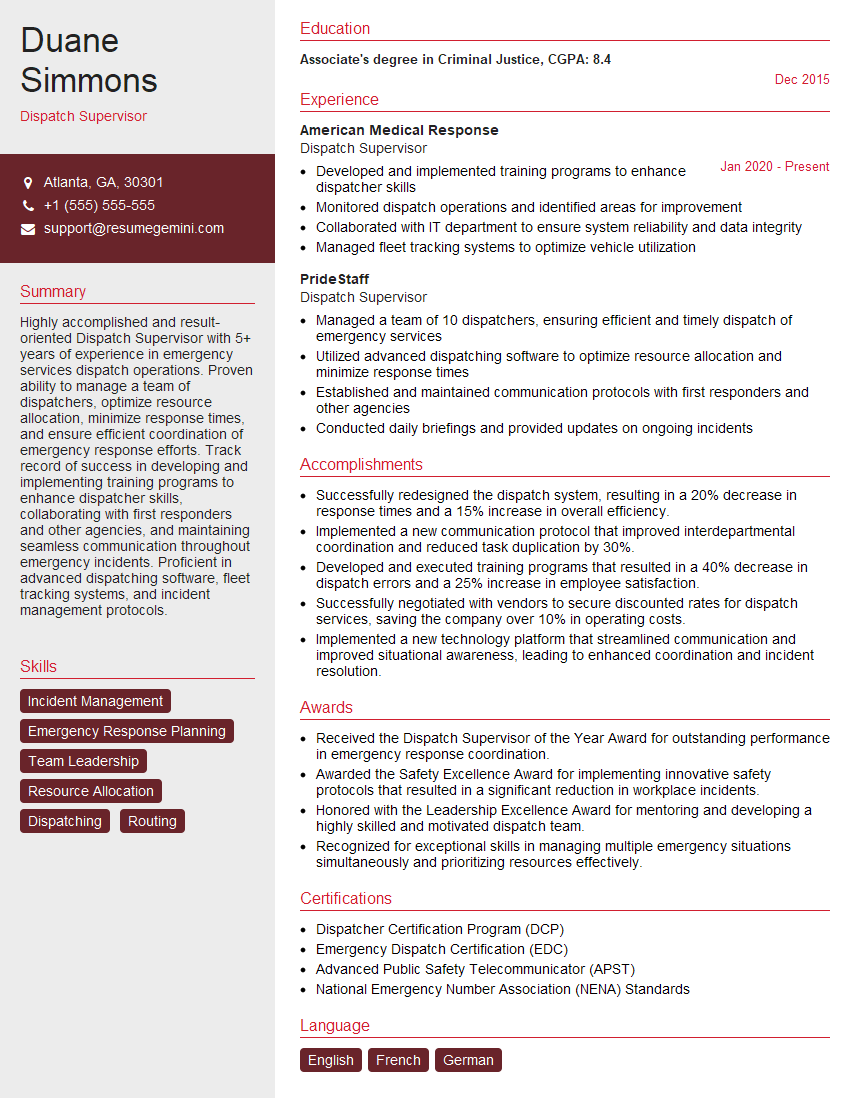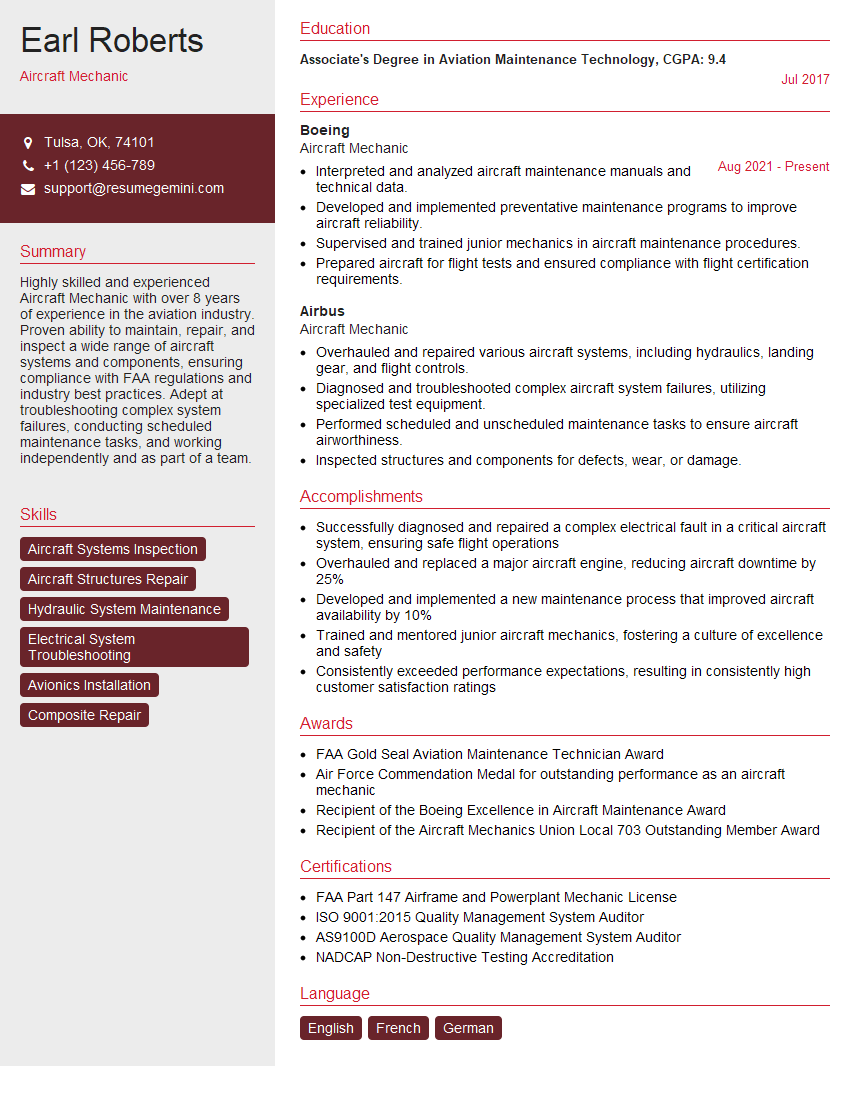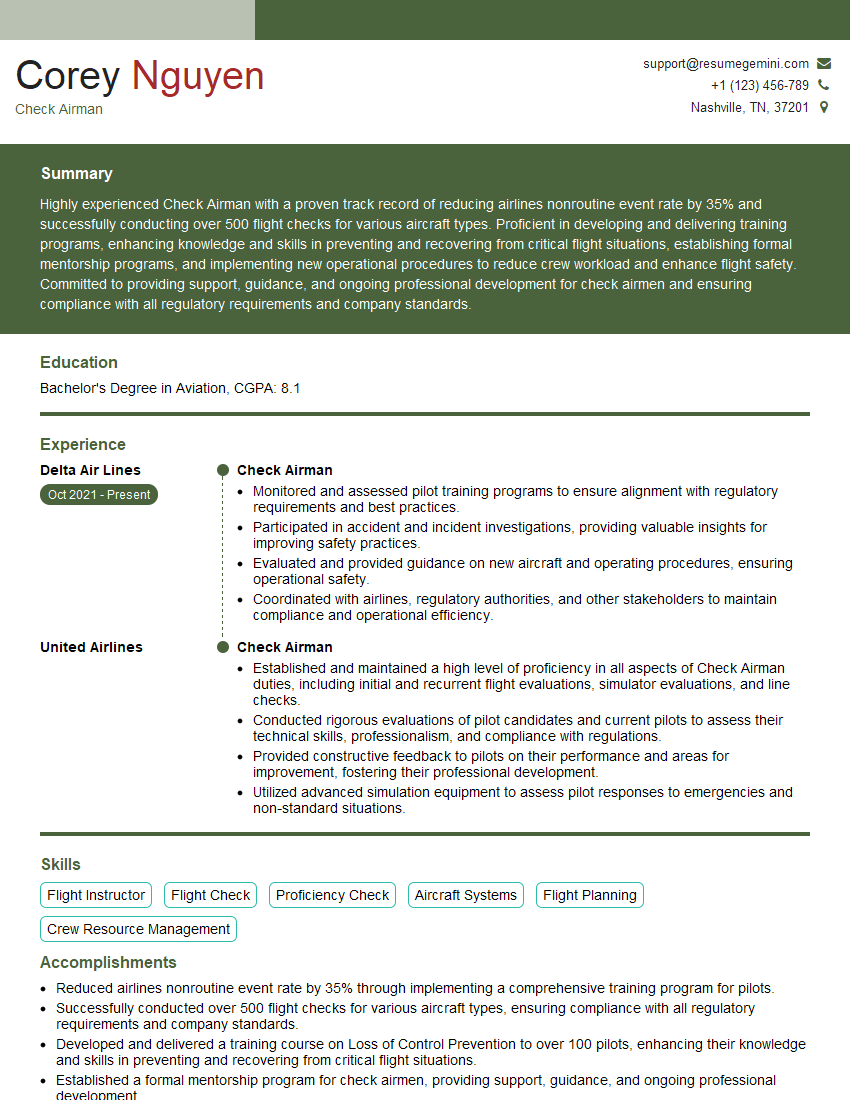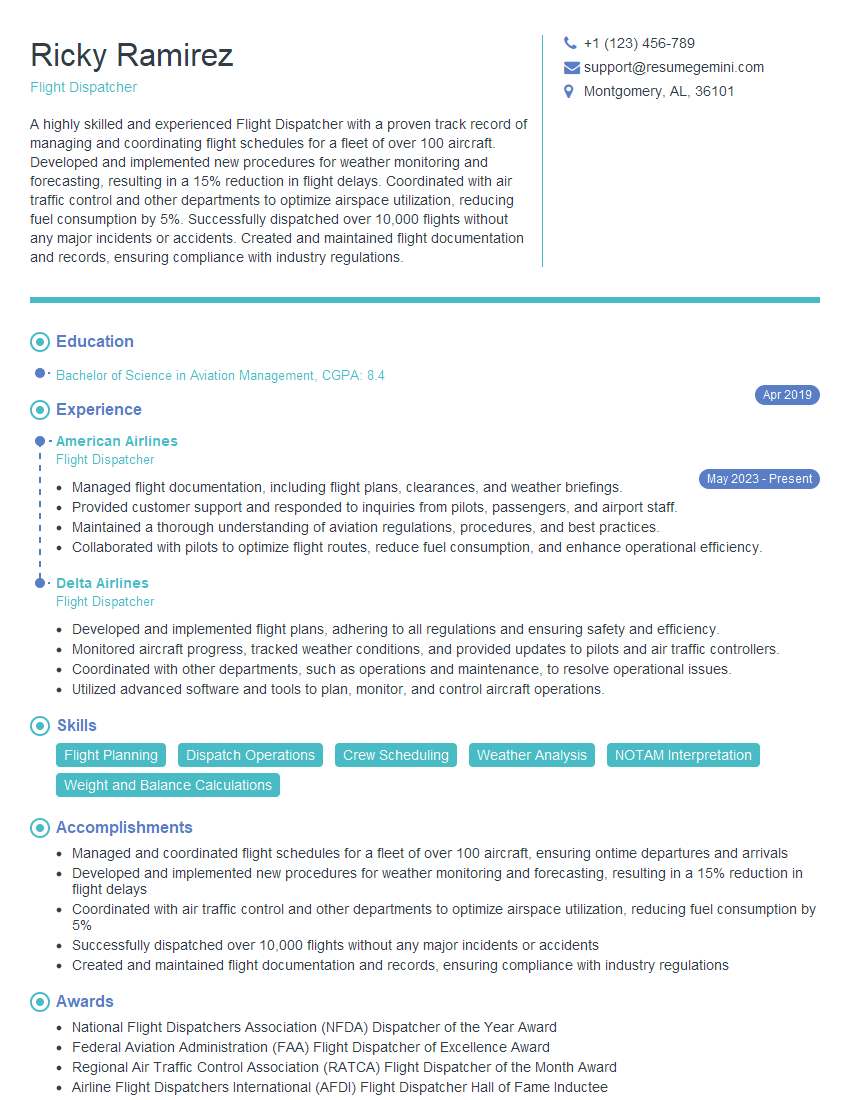Unlock your full potential by mastering the most common Understanding of aircraft performance and operating characteristics interview questions. This blog offers a deep dive into the critical topics, ensuring you’re not only prepared to answer but to excel. With these insights, you’ll approach your interview with clarity and confidence.
Questions Asked in Understanding of aircraft performance and operating characteristics Interview
Q 1. Explain the concept of lift and drag.
Lift and drag are fundamental aerodynamic forces acting on an aircraft. Lift is the upward force that opposes gravity, allowing the aircraft to fly. It’s generated by the shape of the wing (airfoil), which causes air to flow faster over the top surface than the bottom. This difference in airspeed creates a pressure difference, resulting in an upward force. Drag, on the other hand, is the resistive force that opposes the aircraft’s motion through the air. It’s caused by friction between the air and the aircraft’s surface, and by the pressure difference created by the aircraft’s movement. Think of it like pushing your hand through water – the faster you move, the more resistance you feel. Minimizing drag is crucial for efficient flight.
Imagine a bird soaring effortlessly through the air. The curved shape of its wings generates lift, enabling it to overcome gravity. Simultaneously, its streamlined body minimizes drag, reducing the energy required to maintain flight. Aircraft designers meticulously shape wings and fuselages to optimize the balance between lift and drag for maximum efficiency.
Q 2. Describe the factors affecting aircraft range and endurance.
An aircraft’s range (the maximum distance it can fly) and endurance (the maximum time it can stay aloft) are significantly influenced by several factors. These include:
- Fuel capacity: Larger fuel tanks obviously allow for longer flights.
- Fuel efficiency: Aircraft with more efficient engines (lower fuel consumption per distance) can travel further or stay airborne longer.
- Weight: Heavier aircraft require more power to fly and therefore consume more fuel, reducing both range and endurance.
- Altitude and airspeed: Optimum altitude and airspeed exist for maximizing fuel efficiency and consequently range and endurance. This is because the air density affects both lift and drag.
- Headwind/tailwind: A headwind increases flight time and fuel consumption, reducing both range and endurance, while a tailwind has the opposite effect.
- Weather conditions: Turbulence and adverse weather conditions force the pilot to increase fuel consumption.
For instance, a long-haul airliner designed for transatlantic flights will have significantly larger fuel tanks and more fuel-efficient engines compared to a small, short-range commuter aircraft. Flight planning meticulously accounts for these factors to ensure safe and efficient operation.
Q 3. How does weight affect aircraft performance?
Weight has a profound impact on aircraft performance. The heavier the aircraft, the more lift it needs to generate to stay airborne. This increased lift requires more power from the engines, resulting in higher fuel consumption and reduced range and endurance. Furthermore, heavier aircraft require longer takeoff and landing distances, and their maneuverability is reduced. This is because lift is proportional to the square of airspeed (L ∝ V²), so a heavier aircraft needs a higher airspeed to generate enough lift to remain airborne.
Consider a small general aviation aircraft versus a large airliner. The airliner, being significantly heavier, needs a much longer runway to reach the necessary lift-off speed. Similarly, its climb rate will be slower and its fuel consumption higher. Weight management is critical in aviation – even small weight increases can cumulatively affect performance.
Q 4. What are the effects of altitude and temperature on aircraft performance?
Altitude and temperature significantly affect aircraft performance. As altitude increases, air density decreases. This lower density reduces the amount of lift generated by the wings at a given airspeed. Therefore, pilots need to increase airspeed to compensate for the reduced lift at higher altitudes. Higher altitudes also reduce engine performance due to lower air density, impacting thrust. Conversely, higher temperatures also decrease air density, negatively affecting lift and engine performance. The impact of temperature is particularly significant at lower altitudes because the air is denser than at higher altitudes.
Imagine a mountain flight. The thinner air at higher altitudes reduces lift, requiring pilots to adjust airspeed and potentially reduce payload to ensure safe operation. Similarly, a hot day will affect take-off performance due to the decreased air density.
Q 5. Explain the concept of critical Mach number.
The critical Mach number (Mcrit) is the freestream Mach number at which the airflow over any part of the aircraft first reaches the speed of sound. It’s a crucial parameter in aircraft design and operation because exceeding Mcrit can lead to the onset of transonic effects, including shock waves that drastically increase drag and can cause control difficulties. The design of an aircraft must account for this to prevent these effects from occurring during normal operation.
Transonic flight, around Mcrit, represents a complex aerodynamic regime where both subsonic and supersonic flow conditions exist. Careful aerodynamic design, like the use of supercritical airfoils, is essential to minimize drag and ensure safe operation around Mcrit. This is why pilots need to monitor and manage their speed and flight conditions, especially in high-speed aircraft.
Q 6. What is the difference between indicated, calibrated, and true airspeed?
Indicated airspeed (IAS), calibrated airspeed (CAS), and true airspeed (TAS) are all measures of an aircraft’s speed, but they account for different factors. IAS is the airspeed read directly from the aircraft’s airspeed indicator. It’s uncorrected for instrument and position errors. CAS is IAS corrected for instrument and position errors, such as those from the airspeed indicator itself. TAS is CAS corrected for non-standard temperature and pressure, reflecting the aircraft’s actual speed relative to the air mass. Simply put: IAS is what the instrument shows, CAS corrects for instrument inaccuracies, and TAS reflects the true speed through the air.
For instance, flying at a high altitude results in lower air density, meaning TAS will be much higher than IAS or CAS. During flight planning and calculations, it’s crucial to use TAS to accurately calculate flight times, fuel requirements and the true aircraft performance at altitude.
Q 7. Describe the V-speeds of an aircraft and their significance.
V-speeds are a set of airspeeds critical for safe flight operations. They represent key thresholds during takeoff, climb, cruise, descent, and landing. These speeds are usually identified by a letter ‘V’ followed by a subscript. Some key V-speeds include:
- VSO (Stall speed): The minimum airspeed at which the aircraft can maintain level flight. Falling below this speed will result in a stall.
- VSR (Safety speed): Speed at which the aircraft is flying during the approach, and is also commonly used during go-arounds.
- VA (Maneuvering speed): The maximum airspeed at which full control input can be used without inducing structural damage.
- VFE (Best flap speed): The airspeed that allows for optimal flap extension.
- VY (Best rate of climb speed): The airspeed that results in the greatest rate of climb.
- VX (Best angle of climb speed): The airspeed that results in the greatest angle of climb.
- V2 (Takeoff safety speed): Minimum airspeed to safely continue takeoff after an engine failure.
Understanding and adhering to these V-speeds is essential for safe flight. Exceeding VA could result in structural damage, while flying below VSO will result in a stall. Pilots are trained extensively to understand and manage these speeds throughout every phase of flight.
Q 8. Explain the principles of flight planning.
Flight planning is the meticulous process of defining the most efficient and safe route for an aircraft to travel from its origin to its destination. It involves a careful consideration of numerous factors to ensure a successful and compliant flight.
- Route Selection: Choosing the optimal route considering weather, airspace restrictions, and navigational aids. This might involve selecting a shorter route or one that avoids potential turbulence.
- Performance Calculations: Determining the aircraft’s required fuel, speed, altitude, and other performance parameters based on weight, weather conditions, and the chosen route. This is crucial for safe flight operation.
- Navigation Planning: Defining the precise navigation points along the route using navigational aids like VORs (Very High Frequency Omnidirectional Range), GPS, or RNAV (Area Navigation) systems. This ensures accurate flight path adherence.
- Contingency Planning: Identifying alternate airports in case of unexpected events such as weather disruptions or mechanical issues. A backup plan is essential for safety and operational flexibility.
- Regulatory Compliance: Ensuring adherence to all relevant air traffic control regulations, flight rules (VFR or IFR), and national aviation standards. This is critical for flight safety and legal compliance.
For example, a flight from New York to Los Angeles might involve selecting a route that avoids severe weather over the Rocky Mountains, calculating fuel reserves for potential headwinds, and identifying alternate airports in Denver or Salt Lake City.
Q 9. How do you calculate fuel requirements for a flight?
Calculating fuel requirements is a critical aspect of flight planning and safety. It’s not just about the distance; many factors influence the amount of fuel needed. A typical calculation involves:
- Trip Fuel: This accounts for the fuel burned during the flight, from takeoff to landing. It’s determined using flight planning software or charts, taking into account factors like distance, altitude, speed, weight, and wind conditions. A simplified formula is:
Trip Fuel = (Fuel Consumption Rate) * (Flight Time), but real-world calculations are far more complex. - Taxi Fuel: Fuel consumed while taxiing on the ground before takeoff and after landing. This is often estimated as a percentage of the total flight time or based on specific airport information.
- Reserve Fuel: This is crucial for safety and accounts for unexpected events, like holding patterns, diversions, or instrument approach procedures. Regulations dictate minimum reserve fuel requirements, usually expressed in time or distance.
- Contingency Fuel: Additional fuel added for unforeseen circumstances, like unexpected weather changes or mechanical issues. This is calculated based on the flight’s risk profile.
The total fuel requirement is the sum of these components: Total Fuel = Trip Fuel + Taxi Fuel + Reserve Fuel + Contingency Fuel. Imagine a long-haul flight – accurate fuel calculation is paramount, as running out of fuel mid-flight is catastrophic.
Q 10. What are the performance limitations of an aircraft?
Aircraft performance limitations are constraints imposed by the aircraft’s design and operating characteristics. They are crucial for safe and efficient flight. These limitations are typically defined in the aircraft’s flight manual and include:
- Maximum Takeoff Weight (MTOW): The highest weight at which the aircraft can safely take off. Exceeding this limit negatively impacts takeoff performance and safety.
- Maximum Landing Weight (MLW): The highest weight at which the aircraft can safely land. Exceeding this can lead to braking system problems and runway overruns.
- Maximum Zero-Fuel Weight (MZFW): The maximum weight of the aircraft without fuel. This defines the payload capacity (passengers, cargo) for a given flight.
- Operational Limits: These include speed limitations (Vs, VR, V2 etc.), angle of attack limits, altitude limits, and maneuvering speed limits – all critical for maintaining safe operation. Violating these can result in structural damage or loss of control.
- Aerodynamic Limitations: Factors such as stall speed, critical angle of attack, and maneuvering limitations define safe flight envelopes to avoid losing control.
Understanding these limitations is crucial for pilots to make informed decisions about weight and balance, operational procedures and route planning, ensuring safe and legal operations.
Q 11. Discuss the impact of wind on aircraft performance.
Wind significantly impacts aircraft performance. Headwinds (wind blowing against the direction of flight) increase the ground speed needed to maintain airspeed, resulting in longer flight times and increased fuel consumption. Tailwinds (wind blowing in the same direction as flight) decrease the ground speed needed to maintain airspeed, resulting in shorter flight times and reduced fuel consumption.
Crosswinds (wind blowing perpendicular to the flight path) affect takeoff and landing significantly. Strong crosswinds can make these maneuvers difficult and even dangerous, potentially requiring pilots to adjust their flight path or even divert to an alternative airport. Wind shear, a sudden and drastic change in wind speed and/or direction, can also impact aircraft performance especially during approach and landing, potentially resulting in control issues.
Flight planning software incorporates wind information (forecasted winds along the route) to predict the impact on flight time and fuel consumption. Pilots use this information to make decisions on the flight path, altitude, and fuel load. For instance, a flight facing strong headwinds might require more fuel and a longer flight duration compared to a flight with tailwinds.
Q 12. Explain different types of aircraft performance charts.
Aircraft performance charts provide graphical representations of an aircraft’s performance capabilities under various conditions. These charts are essential for flight planning and are specific to each aircraft type. Common types include:
- Takeoff Performance Charts: Show the relationship between takeoff distance, weight, and runway conditions (temperature, pressure altitude, wind). These charts help determine if a particular runway is suitable for a given flight.
- Landing Performance Charts: Show the relationship between landing distance, weight, and landing conditions (temperature, pressure altitude, wind). They help determine the required landing distance and ensure sufficient runway length.
- Climb Performance Charts: These illustrate the climb rate and angle of climb as functions of altitude, weight, and temperature. These assist in planning flight routes and maintaining adequate safety margins.
- Fuel Consumption Charts: Show fuel consumption rates at various altitudes, speeds, and weights. These are crucial for accurate fuel planning and reducing fuel burn.
- Range and Endurance Charts: These present the aircraft’s maximum range (distance) or endurance (flight time) capabilities, factoring in weight, altitude, and speed.
These charts are essential tools for pilots and flight planners. They allow for safe and efficient flight planning by considering various limitations and optimizing flight paths.
Q 13. How does icing affect aircraft performance?
Icing significantly degrades aircraft performance. Ice accumulation on airfoils (wings, tail surfaces) disrupts the smooth airflow, reducing lift and increasing drag. This leads to a reduction in climb performance, a decrease in maximum speed, and an increase in stall speed. The added weight of the ice also affects takeoff and landing distances.
Furthermore, ice can obstruct pitot tubes (airflow sensors for airspeed and altitude), causing inaccurate readings and potentially dangerous situations. Ice accumulation on control surfaces can impair the pilot’s ability to control the aircraft. The increased drag significantly increases fuel consumption. Even a relatively small amount of ice can have a significant negative impact.
Pilots are trained to recognize icing conditions and take appropriate actions, such as diverting to an alternate airport, utilizing de-icing or anti-icing systems, and maintaining flight altitudes above the freezing level. Icing is a serious concern, and avoidance or mitigation are crucial for flight safety.
Q 14. Describe the concept of center of gravity and its impact on flight.
The center of gravity (CG) is the point where the aircraft’s weight is considered to be concentrated. It’s crucial for maintaining stable and predictable flight characteristics. The CG must fall within a specific range defined in the aircraft’s flight manual. If the CG is too far forward (forward CG), the aircraft will be difficult to maneuver, especially during takeoff and landing, leading to difficulties in control and increased stall speed.
If the CG is too far aft (aft CG), the aircraft will be unstable and prone to pitch oscillations, and even potentially to an uncontrollable pitch-up condition. It may also cause problems with elevator effectiveness. An aft CG can lead to a more sensitive flight and increase difficulty in controlling the aircraft.
The location of the CG is affected by the distribution of weight within the aircraft (passengers, cargo, fuel). Before each flight, the CG must be calculated and verified to ensure it is within the acceptable limits. The pilot and crew use weight and balance calculations to carefully manage the loading of the aircraft, ensuring safe and efficient flight. A CG outside the limits can lead to serious flight control problems.
Q 15. What are the effects of high-density altitude?
High-density altitude is the altitude at which an aircraft performs as if it were at a standard sea level temperature. It’s a crucial concept because it considers both altitude and temperature. Hotter air is less dense, so at a high temperature, the aircraft will behave as if it were at a higher altitude, even if it’s at a lower elevation. This is because the air molecules are further apart, offering less lift and increased drag.
Effects of High-Density Altitude:
- Reduced engine power: Engines produce less power in less dense air. Think of it like trying to run a race in thin mountain air versus sea level – it’s harder.
- Reduced lift: The wings generate less lift because there are fewer air molecules to push against.
- Increased takeoff and landing distances: Longer runways might be necessary for safe takeoff and landing due to the reduced lift and engine performance.
- Slower climb rate: The aircraft will climb more slowly due to reduced engine power and lift.
- Increased fuel consumption: The engines will work harder to compensate for the reduced performance, leading to higher fuel burn.
Example: An aircraft at a low altitude on a hot summer day in Denver (high elevation) might experience high-density altitude, requiring longer runways and more careful flight planning than the same aircraft operating under standard conditions at a lower elevation.
Career Expert Tips:
- Ace those interviews! Prepare effectively by reviewing the Top 50 Most Common Interview Questions on ResumeGemini.
- Navigate your job search with confidence! Explore a wide range of Career Tips on ResumeGemini. Learn about common challenges and recommendations to overcome them.
- Craft the perfect resume! Master the Art of Resume Writing with ResumeGemini’s guide. Showcase your unique qualifications and achievements effectively.
- Don’t miss out on holiday savings! Build your dream resume with ResumeGemini’s ATS optimized templates.
Q 16. Explain the concept of load factors.
Load factor refers to the ratio of the lift produced by an aircraft to its weight. It’s essentially how much force the aircraft structure is experiencing relative to its normal weight. A load factor of 1 means the lift equals the weight, resulting in straight and level flight. A load factor greater than 1 indicates that the aircraft is experiencing forces beyond its normal weight, such as during a turn or a maneuver.
Understanding Load Factors:
- Positive Load Factor: This occurs when the lift is greater than the weight, such as during a turn or a pull-up maneuver. It is usually expressed as a number greater than 1 (e.g., 2G, 3G).
- Negative Load Factor: This happens when the lift is less than the weight, for instance, during a loop or an inverted flight. It is expressed as a negative number (e.g., -1G). This can put significant stress on the aircraft.
- Limit Load Factor: The maximum load factor that an aircraft is designed to withstand safely. Exceeding this limit can lead to structural damage. This is specified in the aircraft’s flight manual.
Example: A steep turn puts higher stress on the aircraft structure because the wings need to create more lift than the aircraft’s weight to counteract the centrifugal force trying to pull the aircraft outward. A 2G maneuver would mean the aircraft’s structure is experiencing twice its normal weight.
Q 17. How do you interpret performance data from flight recorders?
Flight recorders, often referred to as ‘black boxes,’ capture various performance data which are crucial for accident investigation, performance analysis, and operational improvements. Interpreting this data requires a deep understanding of aviation principles and the specific parameters recorded.
Interpreting Performance Data:
- Flight Data Recorder (FDR): Contains detailed information about the aircraft’s flight parameters, such as altitude, airspeed, vertical acceleration (g-forces), heading, flight control positions (e.g., flap settings, elevator trim), and engine performance data.
- Cockpit Voice Recorder (CVR): Records the conversations in the cockpit, which provides important context to the flight parameters.
- Data Analysis: Analyzing FDR data usually involves matching the recorded parameters with the flight plan and comparing it to normal operating procedures. Significant deviations from the expected values may highlight abnormal events or possible malfunctions. The process involves identifying trends, correlating parameters, and reconstructing the sequence of events.
Example: A sudden drop in airspeed combined with a high rate of descent and a corresponding increase in g-forces may indicate a stall or a sudden loss of control. By correlating these parameters with the CVR, investigators may determine what actions the pilots took in response.
Q 18. Discuss the role of flight planning software in optimizing performance.
Flight planning software plays a vital role in optimizing aircraft performance and efficiency. These programs use complex algorithms to consider various factors that affect performance, ultimately aiming to reduce fuel consumption, minimize flight time, and enhance safety.
Role of Flight Planning Software:
- Route Optimization: Software uses various algorithms to find the most efficient routes, considering winds, weather conditions, and air traffic control restrictions. This ensures minimum fuel burn and flight time.
- Fuel Calculation: Accurate fuel calculations consider different phases of flight, anticipated headwinds and tailwinds, and reserve fuel requirements, mitigating the risk of fuel exhaustion.
- Performance Calculations: Software can estimate takeoff and landing distances, climb performance, and cruise speed, ensuring safe and efficient operation within aircraft limitations.
- Weight and Balance: Flight planning software helps in correctly calculating the aircraft’s weight and balance, ensuring that the center of gravity remains within the safe limits.
Example: Using flight planning software, a pilot might choose a flight path that utilizes favorable tailwinds to increase ground speed and reduce fuel consumption, even if it means a slightly longer flight distance.
Q 19. How does aircraft configuration (flaps, slats) impact performance?
Aircraft configuration, particularly the use of flaps and slats, significantly impacts performance, especially during takeoff and landing.
Impact of Flaps and Slats:
- Flaps: These hinged surfaces on the trailing edge of the wing increase the wing’s camber (curvature), generating additional lift at lower airspeeds. They also increase drag. Flaps are primarily used during takeoff and landing to reduce takeoff and landing distances.
- Slats: These are similarly deployed surfaces, often located on the leading edge of the wing, that increase the wing’s effective area. Slats improve lift at low speeds and delay stall by increasing the critical angle of attack.
- Combined Effect: Using flaps and slats together significantly increases lift at low airspeeds, shortening takeoff and landing runs. The trade-off is increased drag, which needs to be considered in flight planning.
Example: During takeoff, deploying flaps allows the aircraft to achieve sufficient lift for takeoff at a lower speed, reducing the runway length needed. Similarly, during landing, flaps improve lift at low speeds, allowing for gentler and shorter landings.
Q 20. Explain the different types of drag and how to minimize them.
Drag is the aerodynamic force that opposes an aircraft’s motion through the air. Minimizing drag is crucial for fuel efficiency and performance. There are different types of drag:
Types of Drag:
- Parasite Drag: This is drag caused by the aircraft’s shape and other non-lifting surfaces. It includes form drag (due to the shape of the aircraft), skin friction drag (due to the airflow over the aircraft’s surface), and interference drag (due to the interaction of different airflow streams around the aircraft). Minimizing parasite drag involves streamlining the aircraft’s shape and using smooth surfaces.
- Induced Drag: This drag is created by the lift-generating process itself. It’s a byproduct of the wing’s creation of lift. Induced drag is higher at lower speeds and decreases with increasing speed. Design elements like wing shape and aspect ratio affect induced drag.
Minimizing Drag:
- Streamlining: Designing aircraft with smooth, aerodynamic shapes reduces form drag.
- Low-friction surfaces: Using materials with low surface roughness reduces skin friction drag.
- Optimized wing design: Choosing appropriate wingspans and aspect ratios helps to decrease induced drag.
- Proper aircraft maintenance: Keeping the aircraft clean and maintaining the smooth surface finish helps to reduce drag.
- Careful flight planning: Avoiding unnecessary maneuvers and flying at the optimum airspeed reduce drag.
Example: Laminar flow control (LFC) is a technology that aims to maintain laminar (smooth) airflow over the wing’s surface for longer, significantly reducing skin friction drag. This has been applied to many aircraft designs.
Q 21. What are the effects of turbulence on aircraft performance?
Turbulence is irregular air movement that can severely affect aircraft performance and safety. It causes unpredictable changes in airspeed, altitude, and attitude.
Effects of Turbulence on Aircraft Performance:
- Increased Stress on Aircraft Structure: Turbulence imposes additional stress on the aircraft structure. Severe turbulence can cause structural damage in extreme cases.
- Reduced Passenger Comfort: Turbulence makes flying uncomfortable for passengers and crew.
- Difficulties in Flight Control: Pilots need to use more control inputs to maintain the aircraft’s desired trajectory in turbulence, potentially increasing pilot workload.
- Increased Fuel Consumption: In turbulent conditions, the aircraft consumes more fuel to maintain altitude and airspeed.
- Potential for Damage to Cargo and Equipment: Severe turbulence can result in damage to cargo or equipment on board.
Example: Encountering clear-air turbulence (CAT) unexpectedly can cause sudden drops in altitude and rapid changes in airspeed, which requires immediate pilot intervention to maintain control and prevent further problems.
Q 22. How does engine performance affect aircraft climb rate?
Engine performance is fundamentally linked to climb rate. Think of it like this: a more powerful engine provides greater thrust, the force that propels the aircraft upwards. A higher thrust allows the aircraft to overcome gravity and drag more efficiently, resulting in a faster climb rate. Conversely, a weaker engine, or an engine operating at reduced power, will produce less thrust, leading to a slower climb rate or even a potential inability to climb at all.
Several factors within engine performance influence climb rate. These include:
- Thrust Output: The raw power generated by the engine, directly affecting the aircraft’s ability to ascend.
- Engine Efficiency: A more efficient engine will produce more thrust for the same amount of fuel, improving climb performance.
- Engine Health: Any malfunction or degradation in engine performance (e.g., compressor issues, turbine damage) will negatively impact thrust and, consequently, climb rate.
For example, a high-bypass turbofan engine on a modern airliner is designed for efficient thrust production at lower altitudes, aiding in rapid climb. Conversely, a less powerful engine on a smaller aircraft may require a longer time to reach cruising altitude.
Q 23. Describe different methods of measuring aircraft performance.
Aircraft performance is measured using a variety of methods, both during flight and through ground testing. These methods often involve specialized instrumentation and data analysis techniques.
- Flight Testing: This involves equipping an aircraft with sensors to directly measure parameters like airspeed, altitude, rate of climb, fuel consumption, and engine parameters. Data is recorded and analyzed to assess performance characteristics under different conditions (e.g., varying altitudes, weights, temperatures).
- Telemetry: Wireless transmission of performance data from the aircraft to a ground station allows for real-time monitoring and analysis, crucial during flight testing and for evaluating the performance of remotely piloted aircraft.
- Performance Modeling and Simulation: Sophisticated software uses mathematical models to predict aircraft performance based on various input parameters. This can be used for pre-flight planning, design optimization, and troubleshooting.
- Engine Testing: Engine performance is often tested separately in test cells to determine thrust, fuel consumption, and other characteristics. This data is then integrated into overall aircraft performance models.
For instance, measuring rate of climb involves using altitude and time data. Fuel consumption is typically tracked via fuel flow sensors. These individual measurements are then used in conjunction with other data to gain a holistic understanding of the aircraft’s performance.
Q 24. How do you troubleshoot aircraft performance issues?
Troubleshooting aircraft performance issues is a systematic process involving several steps:
- Data Gathering: Collect all relevant data – flight logs, maintenance records, weather reports, pilot reports, and sensor readings.
- Problem Identification: Analyze the data to pinpoint the specific performance degradation (e.g., reduced climb rate, lower cruise speed, increased fuel consumption).
- Hypothesis Generation: Formulate possible explanations based on the identified problem. For example, is the issue related to the engines, aerodynamics, weight, or atmospheric conditions?
- Verification: Test your hypotheses. This might involve further flight tests, engine inspections, or simulations to isolate the root cause.
- Corrective Action: Once the root cause is identified, take appropriate corrective actions, which might include engine repairs, aerodynamic adjustments, weight reduction, or pilot retraining.
Let’s say an aircraft experiences a reduced climb rate. We would first examine engine performance data for anomalies, then check for any aerodynamic issues (e.g., icing), consider the impact of weight and altitude, and finally assess weather conditions. This methodical approach helps pinpoint the problem and prevent further issues.
Q 25. Explain the concept of thrust-to-weight ratio.
The thrust-to-weight ratio is a crucial performance indicator, representing the amount of thrust an aircraft’s engines produce relative to its total weight. It’s a dimensionless ratio, often expressed as a number or percentage.
Thrust-to-weight ratio = (Total thrust of all engines) / (Total weight of the aircraft)
A higher thrust-to-weight ratio indicates a greater capacity for acceleration, climb, and maneuverability. Aircraft designed for high-performance operations, such as fighter jets, typically have a high thrust-to-weight ratio. Commercial airliners, while not needing the same level of maneuverability, still require a sufficient thrust-to-weight ratio to achieve efficient climb rates and takeoff performance. For example, a fighter jet may have a ratio greater than 1, enabling vertical takeoff, whereas a commercial airliner might have a ratio closer to 0.3. The ratio significantly influences the aircraft’s overall performance capabilities.
Q 26. What are some common performance-related emergencies and their handling?
Several performance-related emergencies can occur. Here are a few examples and their handling:
- Engine Failure: Procedures vary depending on the aircraft type and phase of flight but generally involve identifying the failed engine, managing asymmetric thrust (if applicable), executing appropriate emergency procedures for landing, and communicating with air traffic control.
- Loss of Lift: This can result from various factors such as stall, ice accumulation, or severe turbulence. The immediate response focuses on recovering lift by adjusting pitch, airspeed, and configuration; and if necessary, making an emergency landing.
- Fuel Exhaustion: This demands immediate action, including declaring an emergency, prioritizing fuel conservation measures, and finding the nearest suitable landing site.
Effective handling of these emergencies relies on proper pilot training, adherence to established procedures, and quick, decisive actions. Good communication with air traffic control is essential in all these scenarios.
Q 27. Describe your experience with performance analysis software.
I have extensive experience with various aircraft performance analysis software packages, including industry-standard tools such as [mention specific software, e.g., XFLR5, AVL, or commercial aviation performance analysis software]. My expertise includes using these tools to:
- Model aircraft performance: Predicting climb, cruise, and descent performance under various conditions.
- Analyze flight data: Identifying performance trends, anomalies, and potential issues.
- Optimize flight plans: Determining fuel-efficient routes and minimizing flight time.
- Conduct sensitivity analyses: Evaluating the impact of different parameters on aircraft performance.
For example, I have used [Specific Software Name] to model the impact of different wing designs on the fuel efficiency of a regional aircraft, enabling informed design decisions. I’m proficient in interpreting results, identifying limitations, and translating complex data into actionable insights.
Q 28. How familiar are you with various aircraft performance modeling techniques?
I am highly familiar with a range of aircraft performance modeling techniques, including:
- Classical Performance Methods: These utilize fundamental aerodynamic principles and equations to estimate performance parameters. This approach provides a strong conceptual understanding but can be simplified.
- Computational Fluid Dynamics (CFD): This sophisticated method uses numerical simulations to solve the Navier-Stokes equations, providing highly detailed and accurate predictions of aerodynamic forces and moments, though computationally intensive.
- Flight Simulation Software: These packages offer realistic simulations of flight dynamics, allowing for the testing of different scenarios and maneuvers, particularly useful for pilot training and emergency procedures.
- Empirical Methods: These involve using statistical analysis of historical flight data to predict performance. These approaches are particularly useful when direct theoretical modeling is difficult.
My experience covers selecting the appropriate modeling technique based on the specific problem, accuracy requirements, and available resources. I understand the limitations of each method and can interpret results critically.
Key Topics to Learn for Understanding of Aircraft Performance and Operating Characteristics Interview
- Aircraft Performance Fundamentals: Understanding lift, drag, thrust, and weight; their interplay and impact on aircraft behavior. Practical application: Analyzing flight performance limitations based on environmental conditions (temperature, altitude, wind).
- Flight Planning and Performance Calculations: Mastering techniques for calculating takeoff and landing distances, fuel consumption, and flight time. Practical application: Determining optimal flight paths and fuel strategies for different mission profiles.
- Aircraft Operating Characteristics: Familiarity with aircraft limitations, performance diagrams (e.g., V-speeds), and emergency procedures. Practical application: Responding effectively to unexpected situations during flight, maintaining safety within performance boundaries.
- Engine Performance and Propulsion Systems: Understanding different types of aircraft engines (piston, turboprop, turbofan, etc.) and their performance characteristics. Practical application: Troubleshooting engine-related issues and understanding their impact on flight performance.
- Aerodynamics and Stability: Understanding basic aerodynamic principles and how they influence aircraft stability and control. Practical application: Analyzing aircraft behavior in different flight regimes and understanding the effects of control inputs.
- Weight and Balance: Understanding the impact of weight distribution on aircraft performance and stability. Practical application: Calculating center of gravity and ensuring safe weight limits are observed.
- Performance Limitations and Regulations: Understanding regulatory requirements related to aircraft performance and operational limitations. Practical application: Ensuring compliance with all applicable regulations and safety procedures.
Next Steps
Mastering aircraft performance and operating characteristics is crucial for career advancement in aviation. A strong understanding of these principles demonstrates a commitment to safety and operational efficiency, opening doors to more challenging and rewarding roles. To significantly enhance your job prospects, focus on creating an ATS-friendly resume that highlights your skills and experience effectively. ResumeGemini is a trusted resource that can help you build a professional and impactful resume. We provide examples of resumes tailored to roles requiring expertise in Understanding of aircraft performance and operating characteristics to guide you through the process.
Explore more articles
Users Rating of Our Blogs
Share Your Experience
We value your feedback! Please rate our content and share your thoughts (optional).
What Readers Say About Our Blog
Hello,
We found issues with your domain’s email setup that may be sending your messages to spam or blocking them completely. InboxShield Mini shows you how to fix it in minutes — no tech skills required.
Scan your domain now for details: https://inboxshield-mini.com/
— Adam @ InboxShield Mini
Reply STOP to unsubscribe
Hi, are you owner of interviewgemini.com? What if I told you I could help you find extra time in your schedule, reconnect with leads you didn’t even realize you missed, and bring in more “I want to work with you” conversations, without increasing your ad spend or hiring a full-time employee?
All with a flexible, budget-friendly service that could easily pay for itself. Sounds good?
Would it be nice to jump on a quick 10-minute call so I can show you exactly how we make this work?
Best,
Hapei
Marketing Director
Hey, I know you’re the owner of interviewgemini.com. I’ll be quick.
Fundraising for your business is tough and time-consuming. We make it easier by guaranteeing two private investor meetings each month, for six months. No demos, no pitch events – just direct introductions to active investors matched to your startup.
If youR17;re raising, this could help you build real momentum. Want me to send more info?
Hi, I represent an SEO company that specialises in getting you AI citations and higher rankings on Google. I’d like to offer you a 100% free SEO audit for your website. Would you be interested?
Hi, I represent an SEO company that specialises in getting you AI citations and higher rankings on Google. I’d like to offer you a 100% free SEO audit for your website. Would you be interested?
good


